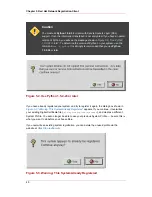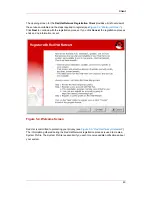
/etc/sysconfig/rhn/systemid 16. enableProxyAuth No 17. retrieveSource No 18.
versionOverride 19. headerFetchCount 10 20. networkRetries 5 21. enableProxy
No 22. proxyPassword 23. noSSLServerURL http://xmlrpc.rhn.redhat.com/XMLRPC
24. keepAfterInstall No 25. proxyUser 26. removeSkipList ['kernel*'] 27.
useGPG Yes 28. gpgKeyRing /etc/sysconfig/rhn/up2date-keyring.gpg 29.
httpProxy 30. headerCacheSize 40 31. forceInstall No Enter number of item to
edit <return to exit, q to quit without saving>:
Enter the number of the item to modify and enter a new value for the option. When you finish
changing your configuration, press Enter to save your changes and exit. Press q and then
Enter to quit without saving your changes.
Important
Although this is not configurable, users should still make note that the port used
by the Red Hat Update Agent is 443 for SSL (HTTPS) and 80 for non-SSL
(HTTP). By default,
up2date
uses SSL only. For this reason, users should
ensure that their firewalls allow connections over port 443. To bypass SSL,
change the protocol for serverURL from
https
to
http
in the
/etc/sysconfig/rhn/up2date
configuration file.
5. Registering with Activation Keys
In addition to the standard Red Hat Update Agent interface,
up2date
offers a utility aimed at
batch processing system registrations: activation keys. Each unique key can be used to register
Red Hat Enterprise Linux systems, entitle them to an RHN service level, and subscribe them to
specific channels and system groups, all in one action. This automation bypasses entitlement
and registration via Red Hat Network Registration Client and Red Hat Update Agent.
Alternatively, both the Red Hat Network Registration Client and Red Hat Update Agent offer the
activation keys utility
rhnreg_ks
as part of their packages.
Note
Systems running Red Hat Enterprise Linux 2.1 need version 2.9.3-1 or higher of
the
rhn_register
package. It is highly recommended that you obtain the latest
version before using activation keys.
Before using an activation key you must first generate one through the RHN website. Refer to
Section 4.6, “Activation Keys —
”
for precise steps.
To use an activation key, run the following command as root from a shell prompt on the system
Registering with Activation Keys
35
Summary of Contents for NETWORK SATELLITE 5.1.0 - CHANNEL MANAGEMENT
Page 1: ...Red Hat Network Satellite Reference Guide 5 1 0 5 1 ISBN Publication date ...
Page 2: ...Red Hat Network Satellite ...
Page 4: ...Red Hat Network Satellite ...
Page 12: ...xii ...
Page 22: ...8 ...
Page 35: ...Figure 2 11 Available Package Updates Available Package Updates 21 ...
Page 52: ...38 ...
Page 74: ...Figure 5 15 Text Mode Welcome Screen Chapter 5 Red Hat Network Registration Client 60 ...
Page 176: ...162 ...
Page 202: ...188 ...
Page 220: ...206 ...
Page 300: ...Your Preferences 71 Index 286 ...
















































